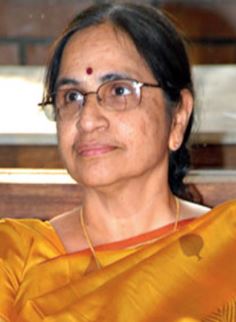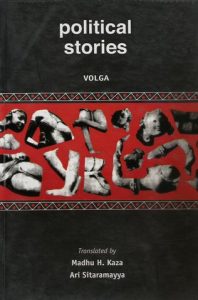
Political Stories by Volga

Author’s Foreword
The choice of the title for this anthology of short stories Political Stories -may surprise many. When one looks at the titles of the stories included in this collection, such as “Sita’s Braid,” “Eyes,” and “Nose-Stud,” it is only natural to ask why the anthology had to be given such an unusual name. It is to explain the reasons behind the choice of the title and to suggest the outlook necessary to understand these stories that I am writing this foreword. You don’t have to read it before you read the stories. In fact, it is better if you read it afterwards.
The stories in this collection are about the web of myths woven around the bodies of women, and the relationships of women with other women, men and society in general. Our literature is strewn with bodies of women. Writers have not spared the description of even an inch of the female body. It is unnecessary to go into the exaggerations and indecencies in these descriptions. Writers have described the female body in ways that they thought were mouth-watering. A collection of the poems and commentaries on women’s bodies would rival the Encyclopedia Britannica in size. The consideration of women’s bodies alternately as attractive and loathsome, and the judgment of women through these colored perspectives became common practice in our patriarchal society. It is no wonder then that the writers who spent so much of their energies describing the physical beauty of women’s bodies also tried to deny women any trace of individuality. Even in Puraanaas such as Bharatam which glimpses of respect for the individuality of women hundreds of poems describe women as base, fickle, and as the cause of all misfortunes. The poets of the Prabandha period imagined women only as objects of pleasure. The Romanticists did to women’s minds what the earlier poets had done to women’s bodies. The Digambara poets were even worse in expressing their disgust with society with great effectiveness, they did not see beyond the bodies of women and mythical entrapments woven around them. Perhaps this should not surprise us. The view, firmly entrenched by the late 1960’s, that women’s bodies were wretched made it easy for Digambara poets to use women in their poems as targets of their attack against society. One doesn’t have to single out the Digambara poets, though. The literature of that time contains plenty of poems in which women and their bodies are debased. Although many progressive and revolutionary ideas were popular at the time, the ideology of the patriarchal society towards women remained intact. It was only when women began to participate in great numbers in revolutionary movements, and challenged the dominating attitudes of men in those movements, that things began to change as far as women’s issues were concerned.
That was the start. Feminism entered our literature slowly, and gradually become a formidable force. In this new atmosphere of feminist idealism, women tried to rediscover themselves. They began to understand their bodies and their natural rhythms not according to the myths and ideologies spread by others, but based on their own experiences. This wasn’t easy, however.
For centuries the body of the woman had been suppressed. It had lost its strength and had become a stranger to the woman herself. Women lost respect for themselves and
began to look down upon themselves. When you think of this degradation, it is heartbreaking. If we look critically at our experiences and the experiences of our fellow women and analyze them, we will come to understand how our society built a deceitful culture around women’s bodies. We will come to understand how gender roles were institutionalized to create “woman”. Such attempts at understanding have been made by women in recent years. Women are writing stories and poetry based on their experiences. As this movement gains strength, and the myths about feminism brought about by western stereotypes begin to fade, a lot of people are beginning to seriously think about and discuss women’s writing. They are welcoming this literature. But there are traditionalists and people who fail to appreciate the change of times. These people claim that feminist writings are inspired less from social awareness and more from awareness of the body and from personal matters. Some have even called these feminist writings blue literature. Whatever they say, it is our responsibility to let society know that when we write about our bodies, it is to express our social awareness and to expose the oppression and exploitation of women that our present society is built upon. Strangely, when we are ready to seriously discuss the ideology behind these issues, there is nobody to discuss it with, nobody to debate. Some drag our personal lives into the discussion as a distraction and create an image that feminism is nothing but confusion. I see no other way but to ignore such folks and go ahead with our work and say what we have to say. But there is a danger that some readers would believe the accusation that our writings are only about our bodily awareness. Due to the dearth of decent literary criticism, it is even harder to find critics capable of analyzing our writings from a feminist perspective. In view of this, I wanted to use this opportunity, offered by the publication of these stories, to talk briefly about the politics of the web of myths and deceits wrapped around the female body. I wanted to emphasize that these are serious stories about this politics. If we had good literary critics it would not have been necessary for me to write this.
How have we understood women’s issues until now? How should we understand them? If we look at recent times a number of concerns have emerged as women’s issues: marriage for child widows, sale of girls, lack of education, dowry, sexual harassment, rape, domestic violence, financial dependence, and many others. For a long time we had thought of these as social evils. In a society devoid of sensitivity, knowledge and a modern outlook, men had created some roles and traditions for women. For a while we thought that if we were educated, and became scientifically knowledgeable, we could recognize these evils and get rid of them. All we needed was a couple of people dedicated to working for the reformation of society. If it became necessary we could pass some new laws. Eventually these evils would disappear and we would get the rights, respect and status that were due to us. That was what we thought then. But the reformers and the laws did little to change our situation. Scores of little girls are being married off even now. The sale of girls (kanyaasulkam) has been replaced by an even worse malady, the dowry. We are all aware how sexual harassment is becoming a nightmare for women who step out of the house for education and employment. Women who are employed don’t have any liberty except for what is granted them by their husbands and fathers. Inequalities in marriage continue unabated.
It is time we ask why it is like this. It is time we realize the so-called women’s issues are not merely some minor desirable, social traditions. We should recognize the very foundations of this exploitative society are built upon the oppression of women. We can’t move forward unless recognize this. Suppression of women is at the core society’s machinations. Our society survives on the oppression of women. We need to understand society not only in terms of goods and services produced, but also in terms of its policies on reproductive rights. Once we do that, we will understand that what we had thought of as women’s issues are manifestations of controls imposed by men on the sexuality and the reproductive rights of women. When we realize how important these controls are for the existence of our society, we can turn our movements and struggles into social and political issues. Once we know where the problems lie, we can aim our weapons at the right places. This simply means we will turn the so-called women’s issues into socio political issues and look for political solutions to the problems. The crux of it is this: if we understand that what we had always thought of as personal problems and family problems are in fact controls the polity has imposed on women in such a clever fashion that we had not even realized it, then we will understand that everything we do in our lives is related to politics
But that is not easy to do. When you begin to question the beliefs that have remained with us for thousands of years, it sometimes feels like our very foundations are being shaken. It is difficult to understand how important our thoughts are about our bodies. It would be an equally difficult struggle to reach the stage where we experience the joy of thinking for ourselves. Women’s impressions of the world, their values and opinions are based on their relationship with their bodies. As a girl becomes a woman, her body changes, too. And the oppressive controls on her begin to increase. Efforts begin from all directions to turn her into a slave. The two oppressions: oppression of the body to oppress her intellect and squash her individuality, and the oppression of the intellect to stint her individuality and diminish her body – are inseparable. But at the same time we are constantly told that the mind and body are separate. Sometimes it is our bodies that are valued more and on other occasions it is our minds.
*****
(To be Continued-)
*****
*Prabandha: A form of Telugu poetry popular in the 16th century.
*Digambara Poetry: Free verse poets of the 1960s: Nagnamuni, Cherabanda Raju, Jwalamukhi, Nikhileswar, Bhairavayya, and Mahaswapna.

ఓల్గా గా ప్రసిద్ధి పొందిన పోపూరి లలిత కుమారి ప్రముఖ తెలుగు రచయిత్రి. ఆంధ్రప్రదేశ్లోని రాజకీయ, సాహిత్యరంగపు చర్చలో స్త్రీవాద ధృక్పధాన్ని ప్రవేశపెట్టిన రచయితగా ఈమెను గుర్తిస్తారు స్త్రీవాద ఉద్యమానికి ప్రతీకగా నిలిచిన ఓల్గా, తనను తాను తెలుగులో గురజాడ అప్పారావు వ్రాసిన కన్యాశుల్కంతో ప్రారంభమైన అభ్యుదయ రచనా పరంపరలో భాగంగా కూడా భావించింది. నవంబర్ 27, 1950లో గుంటూరు జిల్లా చుండూరు మండలం యడ్లపల్లి గ్రామములో జన్మించారు. వీరి తల్లిదండ్రులు పోపూరి వెంకటసుబ్బారావు, వెంకటసుబ్బమ్మ. ఈమె ఆంధ్ర విశ్వవిద్యాలయంలో తెలుగు సాహిత్యం ఎం.ఎ. చేసిన తర్వాత తెనాలిలోని వి.ఎస్.ఆర్. కళాశాలలో తెలుగు అధ్యాపకురాలిగా పనిచేశారు. ఓల్గా కథలు, నవలలు, పద్యాలు మహిళా సాహిత్యములో ఎన్నదగినవి. చలం, కొడవటిగంటి కుటుంబరావు రచనల వల్ల ప్రభావితమై స్త్రీ చైతన్యము అంశముగా రచనలు చేసి తనకై ఒక ప్రత్యేక స్థానము సంపాదించింది. పత్రికలలో, సాహిత్యములో, అనువాదములలో మహిళా హక్కులపై వివాదాస్పద చర్చలు గావించింది. చలన చిత్ర రంగములో ‘ఉషా కిరణ్’ సంస్థకు కథా రచయిత్రిగా పనిచేసి మూడు చిత్రాలు నిర్మించి పురస్కారాలు పొందింది. ఈమె రాసిన స్వేచ్ఛ నవలని వివిధ భారతీయ భాషల్లోకి అనువదించడానికి నేషనల్ బుక్ ట్రస్టు స్వీకరించింది.1986 నుండి 1995 వరకు ఆమె ఉషా కిరణ్ మూవీస్ లో సీనియర్ కార్యవర్గ సభ్యురాలిగా పనిచేసారు. 1991 నుండి 1997 వరకు అస్మిత రిసోర్స్ సెంటర్ ఫర్ విమెన్ కు అధ్యక్షురాలిగా పనిచేసారు. ఆమె ప్రస్తుతం అస్మితలో జనరల్ సెక్రటరీగా పనిచేస్తున్నారు.
